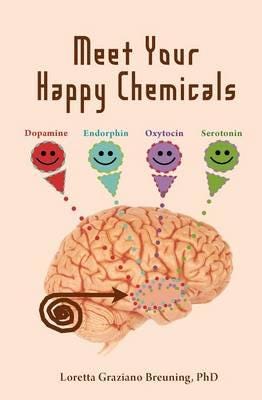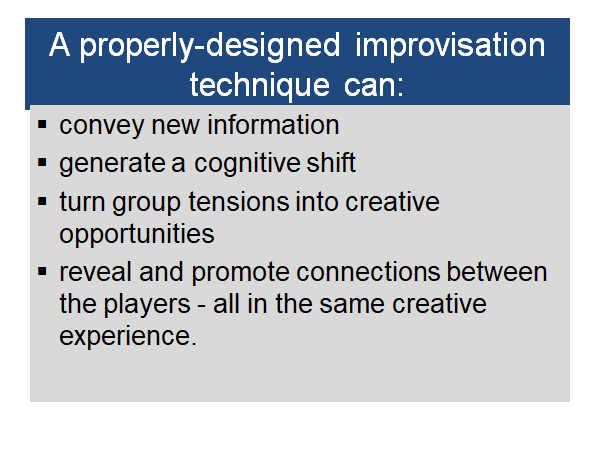The Mental Health Benefits Of Improv: How Making Things Up Together Helps Us Deal With Reality
The Mental Health Benefits Of Improv: How Making Things Up Together Helps Us Deal With Reality


Where an improviser is going, there are no roads, only possibilities. The stage is an empty space that becomes anything at all. A choice is made and another one builds upon it, creating a world that only exists in the collective imagination of the players and the audience. For example, a player sits facing another player, also seated, leaning on an elbow as if there is a table between them. “Sorry I couldn’t take you to someplace a little nicer than this run-down old diner,” he says, then motions to a corner of the stage and tosses an imaginary quarter to his partner. “Go play a couple songs on the juke box.” “A real life juke box? From the olden days?” the other player responds, revealing that this character is much younger. “Yup, like in the olden days, when your mom and I went out on dates before you were born,” the first player says. Now we know they are a father and son. Their tone of voice, eye contact, and physicality establishes a dynamic. This simple, brief interaction is the heart of a human story generated by people having an impact on one another. We see this happen in real time. An improvised story is created at the same time it is told. The players discover the dynamic along with the audience. The improviser’s skills use emotion, action and imagination to produce a story, characters, props — and a world — out of thin air. This rich creative experience is powerfully satisfying to the brain, which feasts on the activity and the joy of discovering moments and scenes that range from wildly comic to wonderfully compelling. The process of brain-to-brain and social-emotional interaction makes improvisation training uniquely effective for strengthening the capacity to cope with uncertainty, manage anxiety and boost the creative thinking that is so essential to navigating an increasingly complex world.


What makes improvisation delightful to experience also gives it a degree of difficulty that sounds intimidating to many people. Deep listening, focused attention, and openness to others’ require effort, emotional risk, and engagement. “When learning is challenging, you have to pay more and better attention to each idea, causing your brain to build stronger connections between neural networks, which embeds the new knowledge for later recall,” write Mary Slaughter and David Rock in
In the workplace wellness programs I design and run, all the classes use Applied Improvisation to deliver a concept folded into a creative, socially-rewarding experience. The program’s objective is to give employees information and tools that are inexpensive, accessible and effective for better health. In real terms, this means providing tools for change. To give something up — like smoking or sugar — or take something up — like exercise or meditation — can be difficult and even painful. It requires a balance of readiness for the discomfort that is an inevitable part of any transition and skills to get through it and sustain the change. Our aim is to try to shift the mindset of people who fear or dread the hard parts of a change process. In one of our classes — “Say Yes To Something New” — we do 2 simple improv games to explore another way to think about change. A game called Radical Acceptance has each participant name 3 things in a random category — animals, colors, chain restaurants — and the entire group shouts “yes” after each thing is named. Then we complicate it just a little. A player is assigned a category. A partner does mot some kind of movement, anything at all and not intended to resemble any actual thing, and the player names that movement in the category after which the group again shouts “yes.” The purpose of this games is threefold:
- provide a jolt of positive emotion from a vocally supportive and enthusiastic group response to the execution of a simple task;
- break up linear thinking and experiment with the radical acceptance of an activity and word that do not go together in any conventional sense;
- produce a rapid cognitive shift into a positive mindset;
Just playing this game transforms what are often a tired, disconnected group of employees into a team rooting for other people they hardly know, if at all. We want to rapidly and dramatically demonstrate that the “new” can wake up both our thinking and emotional brain in a positive way, redirecting the dread and inevitable doubling down into resistance to playful curiosity and a sense of experimentation.


This “yes” exercise is an expression of wholesale acceptance. It is not about approval or judgment. It is, in fact an exercise in approaching the unknown from what is the opposite of fear and dread. The “yes” of improvisation is a connection with what is. A radical acceptance of what is offered. To live in that mindset is to bring the full force of our intellect, emotion and spirit to the moment, which expands our field of awareness so we can build on what is offered, to respond consciously and creatively. “Yes” is an acknowledgement of what is. The “and” is how we shape the next step.
The next game is “This Is Not An Umbrella” in which participants have to transform an umbrella into some other object — swing it like a golf club, carry it like a bouquet of roses, write with it as if it is a pen for a giant. Again, this asks them to do something and somewhat performative, but not so much that the task is overwhelming. This “goldilocks” combination of challenge and unequivocal support is an ideal delivery system for ideas and information. It is therapeutic and change-inducing through engagement that is both simple and fun and sophisticated in terms of its impact on the brain and mind.
Improv training emphasizes the mutually positive embrace of other peoples’ ideas and responses, which can rapidly defuse the anxiety that is an undeniable part of stepping into the unknown, no matter how benign. The openness and receptivity generated by positive experiences expands the field of awareness that enhances our ability to make connections between ideas and make meaning. This translates into greater adaptability and resilience in the face of stress, and receptivity to ideas that we can use to shape our lives in new ways. The fact that we do it together, as a collective, heightens the likelihood we will absorb new information. “The brain is the organ that learns, so it is designed to be changed by your experiences,” writes Rick Hansen of UC-Berkeley’s Greater Good Center, in How To Grow The Good In Your Brain. “Intense, prolonged, or repeated mental/neural activity — especially if it is conscious — will leave an enduring imprint in neural structure, like a surging current reshaping a riverbed. In the saying in neuroscience: Neurons that fire together, wire together. Mental states become neural traits. Day after day, your mind is building your brain. This is what scientists call “experience-dependent neuroplasticity,” which is a hot area of research these days.” In his book Brain Rulesmolecular biologist John Medina explains that “when the brain detects an emotionally charged event, the amygdala releases dopamine into the system. Because dopamine greatly aids memory and information processing, you could say it creates a Post It note that reads ‘remember this.’”
A 2017 study published in the Journal of Mental Healthlooked at improvisation exercises as a therapeutic intervention and found significant improvement in symptoms of anxiety, depression, and reduction of perfectionism — which is a significant source of stress. We apply this knowledge in our wellness class “Changing Mindsets” in which we use games like “Awkward Family Photos” and “World’s Worst” to explore the power of our social networks to shape our behaviors, habits and sense of self. In Awkward Family Photos, group members sit together as a family with a very definable way of being and connection, e.g. a family of cheerleaders, or a family of cat-lovers. Then we add another level of complexity to the family photos, e.g. a family that is extremely competitive, or intellectual, or videogamers. Then we discuss what it would be like for someone from the videogamer family to join the intellectual family, or someone from the cheerleader family to join the cat-lovers. What is it like to join a group that requires us to behave in a way very different from what we have done in the past to belong? What can each character bring with him/her to the new group? What will have to change completely? The issue of belonging is central to the the change process. Beliefs are linked to belonging, which shape our perceptions, all of which power or paralyze our capacity to make change.
The Applied Improv games we use in wellness classes and therapy groups have all the elements that make improvisation look like magic when performed onstage. Through adding details about character and setting to what another player offers, improvisers create a world together. Their commitment to the imagined reality ignites the imagination of observers, who enter a world that is invisible by any rational standard. To co-create an imagined reality with no script nor external direction nor guarantee of success, an improviser relies on a set of thinking and relationship skills that fine-tune the ability to communicate ideas clearly, rapidly assess what others are communicating and respond in ways that support and expand on those ideas. This method that relies on imagination and collaboration to create an entirely invisible world teaches us a mindset and toolkit for coping with the reality we share in daily life.


Jude Treder-Wolff, LCSW, CGP, CPAI is a consultant/trainer and writer/performer. She is President of Lifestage, a NYS-approved provider of Continuing Education for social workers that provides professional and personal development classes and workshops for individuals and organizations. She is host/creator of (mostly) TRUE THINGS, a game wrapped in a storytelling show that is a monthly event on Long Island performed around the country.
